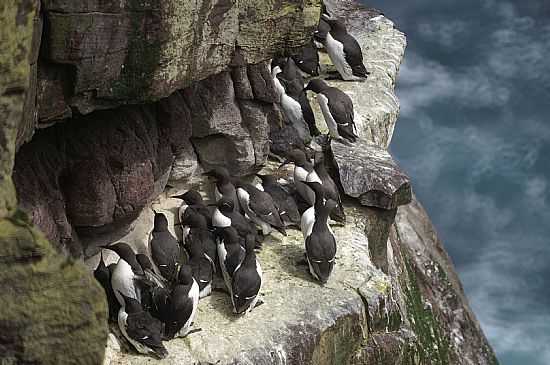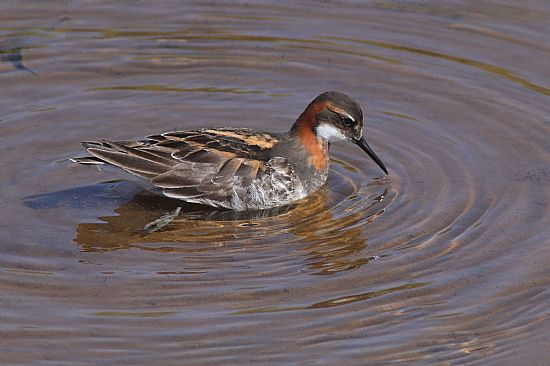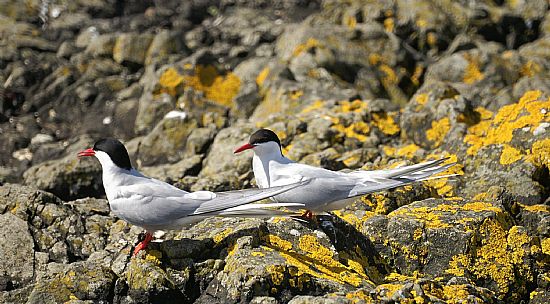Western Isles, 2025
Mark Finn
May 12-18
May 12th: Ullapool-Stornoway ferry, Leverburgh-Berneray ferry, North Uist, Lochboisdale
Daily 37 New 37 Running 37
Weather: Sunny with a brisk NE wind 17c
After making pick-ups in Inverness I headed towards the ferry terminal at Ullapool for the crossing to Stornoway the main town of the Western Isles. The crossing was good for the commoner seabirds once we left the sheltered waters of the mainland. Red-throated and Great Northern Divers were much in evidence along with parties of plunge diving Northern Gannets. A movement of auks was also notable with groups of Common Guillemot and Atlantic Puffins. As we entered the more sheltered waters near Stornoway the group recorded Black Guillemot, Northern Fulmar and Black-legged Kittiwake. The journey to Leverburgh in Harris was tight on time but we managed to catch the ferry over towards Berneray. The crossing was notable for large numbers of Great Northern Divers and Common Eiders plus a few other species seen earlier in the day. North Uist is always good for birds despite the increasing wind levels. The highlight was a Short-eared Owl hunting for voles near the causeway.
May 13th: Lochboisdale, Smerclate, South Glendale, Kildonan, Loch Druidibeg, Ardavachar, Coot Loch, Stinky Bay
Daily 65 New 36 Running 73
Weather: Sunny with NE winds 21c
The first stop today was the local Co-op to try and obtain supplies for the day. No joy with this but a bonus was extended views of a Grasshopper Warbler reeling from a dead bush across the road. It was then time to visit Smerclate which overlooks Barra. A real treat was watching a breeding plumaged Twite feeding on roadside dandelions. At the end of the track I parked up and started watching the sea and adjacent beach area. On the sea we found Great Northern and Red-throated Divers, on the rocks a build up of Sanderling, Dunlin and Ruddy Turnstone in breeding plumage. South Glendale is always worth a visit with this occasion offering us the Hebridean forms of Dunnock and Eurasian Wren. In addition to these birds House Martin and Barn Swallow were also present. I decided to visit Kildonan beach where literally hordes of waders were migrating north to their breeding grounds. A careful search of the flocks added two Purple Sandpipers, Ringed Plover, Eurasian Curlew and Red-breasted Merganser. A bonus came when a migrant Tree Pipit showed well in a pine tree. Lunch was taken at Loch Druidibeg with the added bonus of White-tailed Eagles nesting on an old pine tree. Coot Loch was productive for views of Little Grebe, Common Coot, Eurasian Wigeon, Gadwall, Northern Shoveler and a calling Corncrake. Earlier the beach at Ardavachar hosted a sizeable flock of Bar-tailed Godwits. The road to Griminis did not hold any special species apart from stupendous views of a male Ruff in full breeding dress.
Mammals: Common Otter (1), North Atlantic Grey Seal (c), Common Rabbit (c),

Common Guillemots
May 14th: Daliburgh, Sound of Barra, Eoligarry, Northbay, Vatersay, Castlebay, Glen
Daily 55 New 13 Running 86
Weather: Sunny with light E winds 18c
Today was set aside to visit the southernmost island of Barra with its different habitats and landscapes. A stop at Daliburgh produced the reeling Grasshopper Warbler again plus two Common Whitethroats and a male Reed Bunting. The ferry crossing to Barra was noticeable for high numbers of Great Northern Divers, Common Sandpiper, Arctic Terns, Common Eiders and parties of Common Guillemots. Once on Barra I headed towards the iris beds at Eoligarry which is a prime habitat for Corncrakes and Mary managed to see one in the open and up to six were calling from cover. The woodland at Northbay is always worth checking with today having views of Goldcrest, European Robin and a singing Blackcap. A diversion to Vatersay produced the common birds of Barra so a check of trees around the football ground was taken. A surprise was singing Sedge Warblers in an urban landscape plus Eurasian Wren. Glen is not faraway with many mature trees and scrub attracting passerines. A major find here was a migrant Wood Warbler along with Willow Warbler, Common Whitethroat, Northern Wheatear, European Greenfinch and Common Chaffinch the last two species being recent colonists to Barra. The journey back to Eriksay had several groups of birds including a first year Black-throated Diver a fitting end to the day.
Mammals: Common Otter (1), NA Grey Seal (c), Common Rabbit (c)

Red-necked Phalarope
May 15th: Lochboisdale, Loch Bee, Griminis, Stinky Bay, Sandary, Balranald, Committee Road, Howmore
Daily 62 New 9 Running 95
Weather: Sunny with SE winds 20c
On the road to Daliburgh we encountered a male Hen Harrier and up to four Short-eared Owls. Our first birding stop was Loch Bee which was still and easy to watch in these conditions. I quickly located the long staying Pied Avocet plus Red-breasted Merganser, Eurasian Wigeon, Tufted Duck and Greylag Geese with goslings. A diversion to Griminis allowed us great views of three Red-necked Phalaropes and the male Ruff of a few days ago. Stinky Bay is close by which had similar birds to a few days ago so I pressed on to Sandary in North Uist. On the first scan of the loch we located Whooper Swan, Little Grebe, Tufted Duck and a pair of Common Sandpipers. The fields attracted Eurasian Oystercatcher, Whimbrel and Common Redshank. The best was to come when John located a Corncrake on the edge of an iris bed which gave us close views of up to ten minutes before crossing the road and disappearing into cover. At Balranald we parked up at the far end overlooking the beach and watched the channel towards the abandoned Monarch Islands. On the beach we watched the usual waders and gulls and offshore Great Northern Divers. A Peregrine Falcon had caught a wader and observed flying along the sea before we lost sight of it. A slight diversion to a viewpoint was a remarkable event as St Kilda and its associated islands and the Flannen Islands could clearly be seen in the distance. Committee Road was next on the agenda where White-tailed and Golden Eagles were soaring in the clear blue skies. Last stop was at Howmore which was productive for waders and ducks which included Black-tailed Godwit and a returning Little Tern.
Mammals: Common Otter (1), Common Rabbit (c), NA Grey Seal (c), Harbour Porpoise (2)

Arctic Terns
May 16th: Lochboisdale, Sound of Harris, Luskentyre, Eisgen, Mealabost, Stornoway
Daily 51 New 3 Running 98
Weather: Sunny with SW winds 21c
Today we travelled north towards Stornoway the main town of the islands. The usual birds were seen en route until we reached the picturesque beach at Luskentyre. This is always a good spot for birds with views across to Taransay. Careful scanning of the sea produced sightings of Great Northern and Red-throated Divers, Common Scoter, Arctic Tern, Common Guillemot and Northern Gannets. An added bonus was a Great Skua which is slowly recovering from prolonged periods of bird flu. Near the cemetery a party of European Golden Plovers showed well feeding in a grass field and best detected by their distinctive calls. Eisgen was next an isolated sporting estate reached by a single track road. No sign of eagles today but at the gardens we located Willow Warbler, European Robin, Common Blackbird and the Hebridean race of Song Thrush. Our last stop was at Mealabost with its freshwater loch and adjacent seas. Not too much on this visit as the weather appeared to be ‘too good’.
Mammals: NA Grey Seal (c), Common Rabbit (c)
May 17th: Stornoway, Butt of Lewis, Loch Stiapabhat, Skigersta, Bragar, Lewis Castle, Mealabost
Daily 69 New 7 Running 105
Weather: Sunny with SW winds 21c
Outside our accommodation we added three species which are scarce and localised on the islands notably Western Jackdaw, Rook and Woodpigeon. The first birding stop was The Butt of Lewis the most north-westerly point of Europe. A short seawatch provided us with views of Northern Gannet, Northern Fulmar, Black-legged Kittiwake, Herring and Great Black-backed Gulls, European Shag, Common Guillemot, Razorbill and on the cliff edge Rock Dove and displaying European Rock Pipits. Loch Stiapabhat is nearby and from the hide we observed Whooper Swans, Eurasian Wigeon, Eurasian Teal, Tufted Duck and Northern Shoveler. Waders were few but included Black-tailed Godwit, Northern Lapwing and Common Redshank. A visit to Skigersta added little of note apart from Red-throated and Great Northern Divers so I headed west towards the settlement of Bragar. Lunch was taken here with the commoner passage waders on the beach. After lunch a walk towards the freshwater loch added Common Shelduck but our main targets were European Golden and a vagrant American Golden Plover. The latter was found feeding among the Europeans and stood out with its jet black under-parts and white neck at a distance. In the village of Bragar the group located a few Common Linnets and within the cemetery a pair of Northern Wheatears (Greenland race). It was time to head back to Stornoway and visit the extensive wooded grounds of Lewis Castle. Luck was with us as the highly localised Blue Tit and a male Great Tit were noted the latter being a recent colonist in 2013. With a little time on our hands a return to Mealabost where seven Black-throated Divers were offshore and further up the road a male Hen Harrier flew across the loch.
Mammals: NA Grey Seal, Common Rabbit (c)
May 18th: Stornoway, The Minch, Ullapool, Inverness
Daily n/r New 1 Final 106
Weather: Cloudy with brisk E winds 14c
Our day in Stornoway the ferry departs at 0800 hours for Ullapool. The crossing was good for birds with high numbers of Razorbill and Atlantic Puffin. After about one hour from Stornoway a few Manx Shearwaters were noted heading in a northerly direction. Docked at Ullapool on time where the tour concluded.

